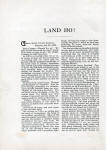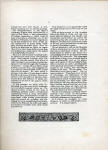| 8 |
eur008 |
LAND HO!
Arran More, County
Donegal,
ireland,
July 18, 1889.
dear citizen:—Hurrah
for us ! We have at
last discovered the great charm of
an ocean voyage, to-wit: the delight
of seeing dry land once more.
At
3.30 a. m. by ship's time (11 p. m.
by
yours) we leave our downy couch and
on
reaching: deck our weary eyes are
greeted with the prominent headlands of
the north coast of
Ireland, mountains that remind us
forcibly of those dear ones at
home, the cliffs bold and distinct in the early morning light, and
headlands sharply cut against
the horizon. The mountains, we repeat, remind us of our own of
Buncombe, but we have not the lovely
sea, the foreground of the picture upon which at this moment our eyes
are feasting.
Everyone is in a good humor. Sickness
and discomfort are forgotten. Even the
poor steerage passengers
are enthused. As we wander amongst them one says:
"Behold, sir, the Gem of the Globe!
You see before you the
birthplace of the European
races. You behold now three
corners of the world, and the whole universe
is needed to make up the fourth."
"Pshaw," say we. "Why, we can wrap
your whole dominion in one corner of
America, so closely that you could never be found."
But
we are all happy, and each rejoice
in
our own dear home.
We
are now, at 7.30 a. m., sailing past
the coast of Londonderry,
the home of our excellent grandfather. Signs of life
seem increasing on all sides, and we have
just met and passed a steamer bound
probably for far-away New
York. We do not envy them the monotonous voyage which is before them. We are at this moment passing Tory
Island very near by on our starboard
bow — a rough, rocky headland
with a prominent light-house.
In front just comes to view Innestrahull,
the point to which we have been
reckoning for many days—the Sandy Hook of North Ireland.
Our
last porridge on the gallant steamer
Nevada has been swallowed, and really
enjoyed, but so many persons have risen
to see land that our share
is curtailed and it seems as awful a crime in us to ask for more as in
poor little Oliver Twist. Perhaps this is a violation of
some Scottish statute; if so, we
will be a frequent offender.
At last we see bonny
Scotland. Two hemispherical rocks stand up out of the
water on our left at considerable
distance and we are told they are the Pass of
Dura. On our right the Loch Foyl indents
deeply the Irish coast. In front is Rathlin's Island, and off our
starboard bow appears what we think
is the famous Giant's
Causeway. In this famous
landmark we are much disappointed. It
is not nearly so impressive as the
Chimney Rocks, on the French
Broad. We are all collected on
the poop deck and, map in
hand, watching every point with deep
interest. The story of the Giant's
Cause-wav is related pleasantly by Mrs. Yon Bulow. How there was
a war between the giants of Ireland
and Scotland, and the former decided to build a bridge to
reach his enemy. The Irish giantess,
to help her husband, carried her apron full
of rocks, but through a rent they
slipped into the sea and
formed the Causeway
Get a map and you can fancy us at
present midway between Rathlin's Island and the shore of Ireland
at county
Antrim. The beaut3' of the shore on both sides is very great. The chalk
cliffs of the
island stand out bold and white and
the emerald shore of the "ould countrie"
is most refreshing to our sea wearied
eyes. All discomforts, stuffy
cabins, bad food, saucy stewards, are forgotten in
the full enjoyment of the scenes now
before us, and all agree that already our |
 |
| 9 |
euroo9 |
voyage hns been well repaid. A real,
happy company arc we all this morning.
Our disappointment at the
Giant's Causeway is more than made good by a sight of Fair Head, a lofty
promontory of Ireland, presenting a seried front of huge rocky pillars
reminding one of the Hudson's
Palisades, but more impressive by far and rendered far more
lovely by the background of green
fields which skirt the bays on either hand. Now indeed is the
time that we begin to regret that
all you dear home folks are not here
and helping us to take this in. Oh,
indeed it is delightfully
beautiful!
We
are at this moment rounding Cant-ire
Head and a most lovely view presents
itself. Ben Lomond looming up in the
distance, with the eternal
blue which of right belongs to
mountains, promises delights
for our ride through the Trossachs
to-morrow. Craige Alice or Alice's
Crag is under our port bow, and a rugged rock
it is, such as a Scotch lassie alone would select for her bower. We now
catch a glimpse of the Isle
of Craig, dear to all us
Scotch as the scene of Robert Bruce's interview
with the spider of historic fame. Viewed from this distance it seems
surrendered to the use of the patron insect
of Scotland.
At
this moment we agree with Dr.
Marshall that the most
lovely landscape we ever beheld is
spread before us. The Island of Arran, owned by the duke of
Hamilton, presents under a foreground of sparkling waves a most
thoroughly culivated area, with beautiful houses on every hand, while
jutting promontories pnsh out toward
us, covering and disclosing
by turns exquisite bays and inlets,
while in the distance the lofty and
rugged mountains of Goat-fell raise their heads
heavenward.
Holy Island is a rock apparently 1,000
feet high which towers over us as we sail
along.
Now we have crossed to the
Ayrshire side of the Frith of Clyde
and the two sweet isles of
Cumbrae, the smaller and the greater, stand before us, and in the
intervening bav the attractive town of
Millport, of wnich the inhabitants
ought to be very good,
because they are allowed to
dwell In paradise already.
We
are tempted to call on the Marquis
of
Bute, whose seat we are now passing,
situated on the Island of Bute. He certainly
seems to deserve the honor of a
call, judging from the good care he seems to take of his
preserves. The thorough cultivation
of every foot of arable land is
already perceptible, and as we
glance again and again at His
Lordship's magnificent domain we catch a parting sight
of the glorious mountains of
Goatfell as tinged by the evening sun that begins
sinking in the west. We are asked
"Are these more lovely than
yours ?" Yes, we must confess
it. These have two points of advantage, the cultivation of the
lands, and the water foreground.
These mountains at which we gaze with rapture are probably not
more than 1,500 feet in height, but
they show all that they have,
because viewed from the sea level,
while ours, four times as high, are
approached so gradually as
to'detract from the
appreciation of their real height.
We
are now passing a perfectly beautiful
little town, Largo, on the Ayrshire
side. Every house seems built of red sand
and fairly glimmers in the sunshine.
At
9 o'clock, yet daylight, we reach
Glasgow, of which we will advise you tomorrow.
It is simply superb. |
 |